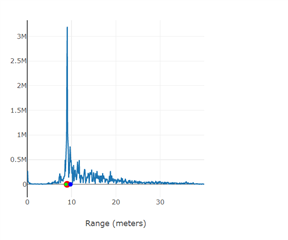Other Parts Discussed in Thread: IWR6843, IWR1642BOOST,
Hi Team,
Currently high accuracy demo gives 3 distances corresponding to 3 peaks in FFT. I would like to get the signal strengths corresponding to these peaks on UART for diagnostic purposes. To implement this, I can see magArray[3] defined in function RADARDEMO_highAccuRangeProc_rangeEst() in the file RADARDEMO_highAccuRangeProc_priv.c
I am trying to push these three values just like 3 estimated ranges being pushed over UART. My modification are as under. I have placed comments to explain the modification and locations where I have modified. After processing, I will compare it with High Accu Demo GUI. I have below questions:
How do I process the magArray after receiving on UART, how does magArray is storing the values of magnitudes?
// Modified the function as below
void RADARDEMO_highAccuRangeProc_rangeEst(
IN RADARDEMO_highAccuRangeProc_handle *highAccuRangeHandle,
OUT float * estRange,
OUT float * estRange1,
OUT float * estRange2,
OUT float * deltaPhaseEst,
OUT float * estLinearSNR,
OUT float * estmag,
OUT float * estmag1,
OUT float * estmag2)
// value of pointers assigned in the same function, after the three peak finder
*estmag = magArray[0];
*estmag1 = magArray[1];
*estmag2 = magArray[2];
// and changed corresponsing structures like below
typedef struct {
uint32_t fft1DSize; /**< 1D FFT size*/
float rangeEst;
float rangeEst1;
float rangeEst2;
float deltaPhaseEst;
float linearSNRest;
float fft1Dinput[2 * MAX_FFT1D_SIZE];
float magEst;
float magEst1;
float magEst2;
} radarProcessOutput_NetworkLink_t;
// basically removed any errors due to undefined or mismacthes in both dss and mss projects
// finally below code in MmwDemo_transmitProcessedOutput()
/*send signal strengths*/
{
MmwDemo_detectedObj dummySignalStrOut;
int32_t tempmag, tempmag1, tempmag2;
tempmag = (int32_t)(outputData->magEst);
tempmag1 = (int32_t)(outputData->magEst1);
tempmag2 = (int32_t)(outputData->magEst2);
memset((void *)&dummySignalStrOut, 0, sizeof(MmwDemo_detectedObj));
// signal strength magnitudes;
dummySignalStrOut.rangeIdx = (uint16_t) tempmag & 0xFFFF;
dummySignalStrOut.x = tempmag >> 16;
dummySignalStrOut.peakVal = (uint16_t) tempmag1 & 0xFFFF;
dummySignalStrOut.y = tempmag1 >> 16;
dummySignalStrOut.dopplerIdx = (uint16_t) tempmag2 & 0xFFFF;
dummySignalStrOut.z = tempmag2 >> 16;



